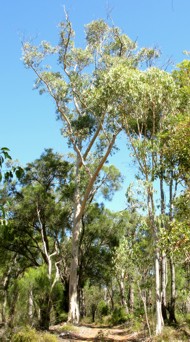 |
|
| torridonbooks.com.au | Information for bushwalkers in Western Australia |
| Home Page | The Books | The Walks | The Gear | ...about ...site map ... contact torridon | |
| Stirling Range | South West Forests | Boranup Karri Forest | Argyle Forest | |||||
Forest DiseasesDie-back disease is the most damaging of the many forest diseases that affect our forests. Itís caused by the pathogen Phytophthora cinnamomi infecting the root systems of native plants. The first sign of the disease is when many of the understorey plants start to die off; the Banksiaís are particularly susceptible to dieback. This is followed by the death of many of the larger trees. The Marri trees are die-back resistant, but Jarrah is most susceptible and a graveyard of dead Jarrah trees indicates the presence of die-back. Another dieback resistant plant is Parrot bush (Dryandra sessilis). This can take over the understorey in die-back affected areas, another strong indicator of the presence of the disease. Warm wet weather enables the pathogen to produce large numbers of mobile spores on the roots of infected plants. These then swim through wet soil and infect neighbouring plants. Transport of soil by vehicles has spread the disease along many of the tracks and roads. Walkers need to be aware of the dangers of spreading die-back when walking through infected areas, in wet weather. |
The South-west ForestsThe South West of Western Australia once supported extensive forests of tall eucalypts and an under-storey of incredible biodiversity. Walking through the patchy and often threadbare remains of this forest we get an idea of what it would have been like, and some clues as to what happened to it. Many of the tracks that we follow are the remains of logging railways, constructed to haul the prized hardwood timber from the forest. This map shows many of the forests and National parks of the south west. The Jarrah-Marri Forest Argyle forest, between Boyanup and Donnybrook, was extensively logged by the Bunnings company in the first half of the twentieth century. Logging ceased almost 70 years ago and much of the forest has grown back, though itís still badly degraded in places. This is state forest and not a National Park; four wheel drive tracks abound and trees are still being felled for firewood. However, some interesting bushwalks, following old logging tracks, are still possible. Karri Forest The Bibulmun Track crosses the Brockman Highway between Nannup and Bridgetown and enters the Karri forest. From here down to Pemberton it burrows through the dense forest. Much of it utilises the remains of an extensive network of old bush railways, constructed to haul the logs to the mills. Several day walks, through dense Karri forest, can be made from Donnelly River Village. The walk along the Bibulmun track between Donnelly River village and Pemberton is also recommended. Itís a five day walk with four nights in the track huts. Youíll need to make some arrangements to have someone drop you off and pick you up at the start and finish of the walk. Boranup Forest in the Leeuwin-Naturaliste National Park is easily accessible, just 20 kilometres south of Margaret River. A 15 kilometre circular walk through the forest is described here. Tuart Forest |
The Trees
|
Last updated March 2010
© A T Morphet

